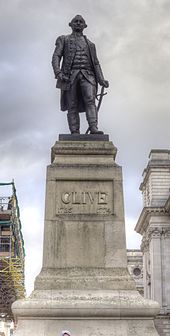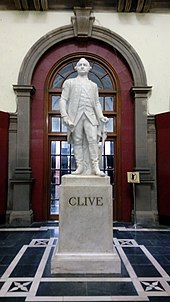Statue of Robert Clive, London
| Statue of Robert Clive | |
|---|---|
 The statue in 2010 | |
 | |
| Artist | John Tweed |
| Year | 1912 |
| Medium | Bronze |
| Subject | Robert Clive, 1st Baron Clive |
| Location | King Charles Street,LondonSW1 |
Listed Building– Grade II | |
| Official name | Statue of Clive on steps at west end |
| Designated | 14 January 1970 |
| Reference no. | 1221431[1] |
A Grade II-listed bronzestatue ofRobert Clive, 1st Baron Clive,byJohn Tweed,stands in King Charles Street,Whitehall,London.[2]The work was unveiled in 1912 outsideGwydyr House,also in Whitehall, and was moved to its current location in 1916.[3][2][1]
Description
[edit]On the west face of the plinth are Clive's surname and the year of his birth and death (1725–1774).[4]The remaining three sides have bronze reliefs depicting events in his life: theSiege of Arcotin 1751, the eve of theBattle of Plasseyin 1757 and theTreaty of Allahabadin 1765.[4]
History
[edit]On 8 February 1907,Sir William Forwoodwrote toThe Timesnoting that there were no monuments to Clive in London or India, and that even his grave, in the church atMoreton Say,Shropshire,was unmarked.[5]Lord Curzon,aConservativepolitician and the formerViceroy of India,wrote in support of Forwood's complaint, though he noted that in 1860 Clive had been "tardily commemorated by a statue atShrewsbury".[6]A Clive Memorial Fund committee was established, with Curzon publicising the fundraising efforts and progress with further letters to the editor of theTimes.[7]An 18th-century statue of Clive byPeter Scheemakersinside theIndia Officewas then brought to Curzon's attention, but Curzon considered neither its portrayal of Clive nor its location to be adequate.[8]The fund raised between £5,000 and £6,000 to erect memorials to Clive in London andIndia.[5]Curzon's proposal did not meet the favour of his successor as viceroy,Lord Minto,who considered a commemoration of Clive "needlessly provocative" in India at a time of agitation and unrest inBengal,where Clive had been the first British governor.[9] [10]
John Tweed was commissioned to start work on the London statue and exhibited a sketch model at theRoyal Academyin 1910.[11]The statue was unveiled in a temporary location in Gwydyr Street in 1912.[12]It was moved to its permanent location in 1916.

The statue is placed on a high plinth, inlaid with bronze bas-relief on three sides, depicting three historic scenes associated with Clive's career in India. The scenes are: the siege of Arcot, the Battle of Plassey 1757 and the Grant of Diwani by the Mughal emperor to the British East India Company, represented by Clive, in 1765.

A smaller version of the finished statue, also cast in bronze, is now part of the collection of theTatein London.[11]Other works by Tweed portraying Clive include a memorial tablet in the south choir aisle ofWestminster Abbey,erected by public subscription in 1919,[13]and a marble statue at theVictoria MemorialinKolkata,India.[14]

21st century
[edit]At the beginning of the 21st century, the statue was singled out for criticism by Nick Robins in his history of the East India Company,The Corporation that Changed the World.In the book, he argued that "the fact that one of Britain's greatest corporate rogues continues to have pride of place at the heart of government suggests that the British elite has not yet confronted its corporate and imperial past." The book concluded by calling for the statue to be removed to a museum.[15]
In June 2020, calls were made for the statue's removal after awave of anti-racism protestsin which astatue of the slave trader Edward ColstoninBristolwas pulled down. TheLabourpoliticianLord Adonisasked the Government to begin a public consultation on the statue.[16]Clive's statue will be considered in a review of London's public monuments ordered bySadiq Khan,theMayor of London.[17]With Andrew Simms, Nick Robins repeated his call for the statue to be removed and replaced with a monument celebrating a new generation of diverse global heroes.[18]The historianWilliam Dalrymplecompared the statue's 20th-century memorialisation of Clive to theConfederate monumentserected in theSouthern United Stateswell into thecivil rights era.[9]The writerAfua Hirschsimilarly said that the statue was "not a piece of history but an attempt – when it was erected centuries after Clive's death – to rewrite it" and called Clive "a symbol of the most morally bankrupt excesses of Empire".[16]
See also
[edit]- Bali Bombings Memorial, London,located nearby
References
[edit]- ^abHistoric England."Statue of Clive on steps at west end (1221431)".National Heritage List for England.Retrieved26 September2014.
- ^ab"Statue: Lord Clive".London Remembers.Retrieved26 September2014.
- ^"Statue of Lord Clive".Discovery.The National Archives (United Kingdom).Retrieved26 September2014.
- ^ab"Robert Clive – London, UK – Statues of Historic Figures".Waymarking.Retrieved26 September2014.
- ^ab"The campaign to remember Clive of India".Shropshire Star.27 May 2011.Retrieved26 September2014.
- ^Ward-Jackson, Philip (2011),Public Sculpture of Historic Westminster: Volume 1,Public Sculpture of Britain, vol. 14, Liverpool: Liverpool University Press, p. 109,ISBN978-1-84631-691-3
- ^Curzon. (13 August 1907). "Clive Memorial Fund".The Times.
- ^Ward-Jackson 2011,pp. 109–110.
- ^abDalrymple, William(11 June 2020),"Robert Clive was a vicious asset-stripper. His statue has no place on Whitehall",The Guardian,retrieved11 June2020
- ^Gilmour, David (2019).Curzon: Imperial Statesman.Penguin. p. 371.ISBN978-0141990866.
- ^ab"John Tweed Lord Clive c.1910–12".Tate.Retrieved26 September2014.
- ^"Robert Clive (1725–74) | Statue by John Tweed, 1912".English Heritage.Retrieved4 February2024.
- ^"Robert Clive".Westminster Abbey.Dean and Chapter of Westminster.Retrieved26 September2014.
- ^"Sculptures and Statues".Victoria Memorial (India).Retrieved26 September2014.
- ^Robins, Nick. (2012).The corporation that changed the world: how the East India Company shaped the modern multinational(2nd ed.). London: Pluto Press.ISBN978-1-84964-691-8.OCLC820849779.
- ^ab"The Londoner: Now Clive of India is a monumental problem",Evening Standard,9 June 2020,retrieved11 June2020
- ^Bland, Archie(10 June 2020),"After Colston, figures such as Drake and Peel could be next",The Guardian,retrieved11 June2020
- ^Andrew Simms (10 June 2020)."Reckoning with Britain's imperial legacy: time to search for new heroes".New Weather Institute.Retrieved20 June2020.
External links
[edit] Media related toStatue of Clive of India, Londonat Wikimedia Commons
Media related toStatue of Clive of India, Londonat Wikimedia Commons- English Heritage webpage on the statue
